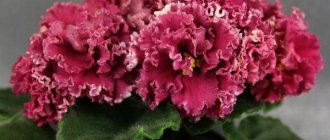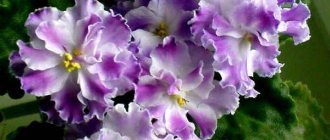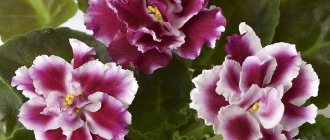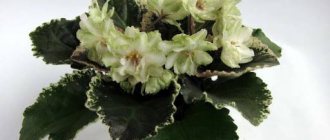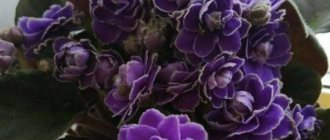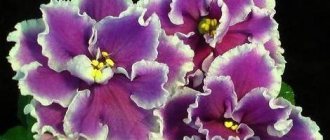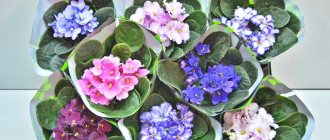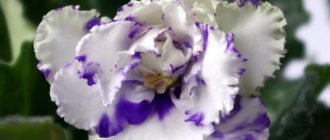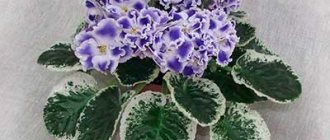Violet LE-Winter's Tale
Author of the variety
The magnificent violet LE-Winter's Tale of the most delicate shades is a representative of many years of breeding developments by Elena Anatolyevna Lebetskaya , a passionate florist from Vinnitsa and a master of creating new varieties of Saintpaulia with a name widely known among violet lovers.
Its portfolio already includes more than four hundred different varieties of exotic beauties, which enjoy constant success among violet growers.
The variety has regularly participated in flower exhibitions since 2008.
Taxonomy
LE-Winter's Tale according to taxonomic classification represents the genus Saintpaulia, belonging to the Gesnerieceae family .
The diameter of the medium-sized leaf rosette allows us to classify the variety as a standard type, the shape of the corolla is determined by the “star” type, and by the color of the flowers it is a fantasy group.
Photo and description of appearance
The violet forms a magnificent rosette of a standard type with a symmetrical configuration, which especially distinguishes the E. Lebetskaya variety, and is lushly filled with leaf blades.
Quite large leaves are supported by strong petioles , which allows you to create a high bush outline. The petioles of the lower, more mature leaf blades are somewhat elongated - this can lead to the tips of the leaves being tucked towards the flowerpot.
The leaf blades are distinguished by their summer green color, brightly pressed venation, quilted surface structure and wavy-curved side edges with rounded serrations.
Violet flowering occurs in a bouquet type with long-term preservation of the fresh and decorative state of each bud, but without particularly large numbers of buds. The corollas are large stars of single or semi-double fullness, to which additional volume is given by the densely corrugated edges of the petals.
The coloring of the corollas is distinguished by the transitions of the main white color into pink waves of the edge with spots of the same scale of various shapes throughout the flower and bluish-lilac fancy strokes and specks concentrated closer to the fringe.
Important! The thin contour of the edge of the petals at the beginning of flowering is often painted in a salad color; over time, this color disappears completely.
Sports
The variety belongs to a surprise group - it produces numerous sports in almost half of the cases. According to the breeder’s descriptions for sporting, there are two varieties:
- sport 1 gives a bluish-purple edge around the white main background of the petals with a thin green border;
- sport 2 is distinguished by its chic colors in the style of a Venetian masquerade: along the pink field of large corollas of terry or semi-double fullness, lilac specks, lines, dots and spots are abundantly distributed, sometimes turning into small sectors. The picture is completed by a thick frame of a salad shade along the contours of the petals;
- but sometimes it sports not according to the description of E. Lebetskaya , but with the formation of a simple border of lilac tone of varying width and intensity.
All changes during the formation of sports at LE-Winter's Tale concern only the color of the corolla.
Violet selection
To obtain a new variety, several methods are used:
- The most common is dusting between varieties;
- Next, we can name the consolidation of the characteristics of the violet sport; for this, it is usually propagated by its peduncle;
- Also, new varieties of sports can be obtained by propagating chimeras with leaves, then the resulting result also needs to be consolidated.
Violet EK-Winter's Tale
Author of the variety
The gorgeous variegated Saintpaulia EK-Winter's Tale was obtained by a domestic breeder from Tolyatti with the name Elena Vasilyevna Korshunova, .
The master has been engaged in selection since the last decade of the last century; he has an extensive selection line of varieties with the branded prefix EK, many of which are popular with Russian and foreign flower growers.
The variety was introduced to a wide range of gardeners in 2010.
Taxonomy
According to scientific classification, EK-Winter's Tale is a variegated variety belonging to the genus Saintpaulia from the Gesneriev family .
It belongs to the standard type according to the characteristics of the leaf rosette, to the semi-double group - according to the fullness of the corolla with petals, and to the fringed type of corolla - according to the ruggedness of the edges of the petals.
Photo and description of appearance
The violet forms a magnificent standard-type leaf rosette with a symmetrical configuration, an even contour, an average degree of fullness and a mosaic distribution of leaves.
Based on the type of leaf color, the variety belongs to the variegated group of the bordering species.
The rounded leaf blades are characterized by a smooth surface, finely notched serration of the lateral edges, a lighter venation pattern and the color of the main background in the tone of dark green with white patterns running along the edge of the leaf in the form of ribbons, strokes and specks.
Attention! With age, the pattern acquires a delicate lemon tint.
The violet blooms in a cap type , forming a mass of gigantic diameter corollas that retain their decorative properties for a long time with semi-double fullness and heavily fringed petals.
The color of the buds is dominated by white tonality , smoothly flowing into the central eye of the pink range and intersected by diametrical stripes of weak blue intensity. Pale blue fantasy strokes flicker throughout the space of the corolla.
Sports
Saintpaulia E. Korshunova is distinguished by her ability to frequently engage in sports , which are of two types:
- the sport described by the author forms not white, but completely lilac-colored corollas with blue fantasy strokes on all petals;
- There is another variant of the sport: almost the entire surface of the corolla is painted in bluish-gray shades with rays and fancy specks.
When sport forms in violets, the variegation and shape of the rosette do not change; all transformations affect only the color of the corollas.
Is it possible to breed a new variety at home?
For those who want to try themselves as a breeder, it is worth knowing the intricacies of breeding varieties using each of the popular methods:
- by seeds: two Saintpaulias are selected, for this purpose the dominant and recessive characteristics of each variety are taken into account;
- carry out pollination;
- the resulting seeds are sown;
- during the growth process, unsuitable varieties are sorted out - incorrect rosette, ugly flowering, flowers that are too small (most of the features manifest themselves completely on the second flowering);
- selected varieties are tested for resistance, propagated by leaves until the third generation;
- varieties that repeat themselves can be called new, provided that there is no such variety previously bred by others.
One way to get a new variety of violet is by propagation by seeds.
- fixing a random variety - if during propagation a new variety accidentally appears (especially often when chimeras are propagated by leaves): the sport is propagated by several generations, at least three (most often by a peduncle);
- after obtaining stable repetition from generation to generation, the variety is considered newly bred.
Important! Every novice breeder should familiarize themselves with the list of already bred varieties in the world, because often, having studied only domestic ones, inexperienced flower growers attribute someone else’s variety to themselves.
Care in indoor culture
Violets of the “Winter Tale” variety are not flower whims - they easily adapt to the proposed microclimate, bloom well under the classic set of maintenance regimes, but still have minor differences in the care system.
Indoor conditions
The place for violets in indoor culture is determined in accordance with their relationship to lighting:
- on north-facing window sills, the plant will require additional illumination with fluorescent spectrum lamps;
- on the south side there will be a need to shade the violets from the hot rays of the sun;
- It may be ideal to place violets on windows facing east or west - here they will have enough light for growth and development, but there will be no danger of overheating or burns, since direct rays of the sun do not reach here.
IMPORTANT! Both varieties of “Winter's Tale” violets bloom more readily and more luxuriantly on window sills - they do not really like to be on shelves indoors and can stop or delay flowering.
Watering and fertilizing mode
For violets to feel comfortable, the watering regime should include a set of various measures :
- watering is carried out after the substrate has sufficiently dried, which is determined visually;
- a good drainage system in the flowerpot must be provided;
- one of the types of watering is selected - top under the root, wick or through a tray;
- Monitoring is carried out to ensure that drops fall on the leaves and that excess water is drained from the pot.
Preserving the decorativeness and health of violets requires mandatory feeding once a month , but only if absolutely necessary - the varieties do not tolerate overfeeding.
It is worth feeding violets once a month.
Fertilizing rules guarantee synchronization of the application of certain elements with the life stages of violets:
- to increase the growth of the leaf rosette, increase the percentage of nitrogen;
- When buds form, more potassium and phosphorus are needed.
For variegated varieties, control over the amount of nitrogen - with a large proportion of it, the variegated pattern may disappear, since nitrogen is responsible for the formation of chlorophyll.
Light level control
Violets "Winter's Tale" love fairly long-term illumination with a diffuse spectrum . The better the lighting, the stronger the manifestation of the fancy coloring of the corollas and the variegation of the leaf blades.
But it must be remembered that the close placement of daylight lamps for additional illumination can provoke the disappearance of the framing contour and spotting of the petals and leaves.
Controlling the level of light also involves systematically changing the position of the flowerpot relative to the light source to form a beautiful rosette.
Temperature
Classic temperature indicators for violets usually range between +20 + 24°C , although in winter they can be reduced by 2 - 3°C. The same indicators will help the violet maintain the freshness of its buds longer during flowering.
Fantasy and variegated varieties of violets feel much more comfortable in a cooler microclimate - within +18 + 20°C.
With this content, the color of the corollas and the variegated patterns of the leaves will be much brighter and more expressive than in warm conditions.
ATTENTION! At any period of life, plants should be protected from sudden changes in temperature and drafts.
Effect of air humidity
Violets prefer ambient humidity slightly higher than normal room humidity. Therefore, it is imperative to increase the humidity:
- using various humidifiers;
- frequent spraying near the violet, but not on it.
Soil requirements
The substrate for Saintpaulias is light, nutritious due to the optimal content of macro- and microelements in it, permeable to water, with good aeration.
The soil for violets should be very light.
All these qualities can be improved with the help of a well-designed drainage system, as well as by adding drainage materials and antiseptic substances to the soil.
Pruning and hygiene
To preserve decorativeness and prevent decay, preventive cleaning to remove old, diseased or damaged leaves and stems, faded buds and excess shoots that interfere with the optimal development of violets.
Transplant rules, rejuvenation
Young specimens of violets are usually replanted once a year, after flowering, older plants - as needed.
Before transplantation, the following preparatory measures are required:
- choosing a plastic pot of the desired diameter;
- purchasing fresh soil in the store;
- arrangement of drainage.
CAREFULLY! The choice between transplantation and transshipment is made in connection with the objectives:
- if it is necessary to increase the volume of the pot, transshipment will do;
- To fully diagnose the root system, a transplant is needed.
Rejuvenation of the plant is carried out approximately in the fifth year of the violet’s life - the smooth, healthy top is cut off and rooted in a new flowerpot. During rejuvenation, varietal qualities are preserved.
Selection of Elena Vasilievna Korshunova
Elena Vasilievna Korshunova was born on May 14 in the city of Uralsk (Western Kazakhstan). The woman has been growing flowers since childhood. She brought cuttings of flowers, rooted them in water, and planted them in soil that she brought from the dacha. At that time, there were no specialized mixtures, so the girl herself selected the soil for her plants.
There are many EK varieties of violets
After graduating from school, I entered the Polytechnic Institute in Samara at the Faculty of Computer Science and Informatics. Since 1992 he has lived and worked in the city of Tolyatti. Married, has a son and daughter.
Advances in breeding
The woman began breeding in the mid-90s. The first plants obtained are still popular. Among them are the following varieties: Goddess of Beauty, Tender May, Black Pearl, Masterpiece of the Artist, Kingdom of Neptune.
Work on new species is proceeding according to a specific plan. First of all, the selection of suitable pairs is thought out to obtain the desired result. Direction of work - large-flowered violets, different colors and shapes.
On a note! At the moment, Elena Korshunova is known not only in Russia, but in foreign countries. Her works have won prizes at exhibitions more than once.
Over 20 years of work, the woman managed to obtain unique violets, which have no analogues. For example: Velvet Queen, Marigold, Martian, Mosaic, Snow Leopard.
Features of flowering, growth and reproduction
According to these life cycles, both “fairy” violets have many common characteristics, although they still differ in some nuances.
Plant development in home collections
Violet LE-Winter's Tale develops and grows easily , but at a somewhat slower pace, forms a rosette with an even contour and bright greenery.
LE-Winter's Tale independently forms an even rosette.
It does not form a large number of buds, and the corollas remain fresh for a long time.
The variety is not distinguished by a large number of children produced; it loves to exercise.
Violet EK-Winter's Tale does not require special care, grows calmly, and forms an exhibition-looking rosette of gorgeously colored variegated leaves.
Forms very large corollas , gathered into a cap in the center of the rosette, which are capable of not losing their decorative appearance for a long time. It tries to bloom almost without interruption.
For the brightness of fancy shades and variegation in the color of the leaves, violets need coolness and good lighting; for more luxuriant flowering - location on the windowsill.
Varieties tend to exhibit their specific characteristics with increased intensity as the number of blooms increases. In young children, the fancy coloring of the corollas and the variegation of the leaf blades is very weak.
The fantasy color becomes brighter with each flowering.
Time of formation of an adult plant
The duration of obtaining an adult plant capable of forming buds depends on the source material.
When growing a violet using a leaf, it will take about two months for the formation of young layers on it and about another eight for the growth of a leaf rosette. If rooting begins in early spring, the first flowering may occur by mid-winter.
to form an adult violet from a ready-made baby , since you do not need to wait for the young plant to grow, it is already ready.
Reproduction methods and features
To obtain a young plant, various propagation methods are possible:
- seeds, that is, the sexual method is complex, time-consuming, and is used by breeders when breeding new varieties. It is not used in common practice, since it does not retain parental characteristics when propagating hybrid forms;
- leaf cuttings;
- dropping off stepchildren.
ADVICE! To preserve the qualities characteristic of hybrid varieties of violets, it is most advisable to use the rejuvenation method. If it comes to variegated varieties, then you should definitely choose green leaf blades on the violet - they are able to feed themselves through photosynthesis until rooting.
Flowering in hot and cool conditions
Violets of the “fairytale” group belong to the fantasy and variegated types, which grow and bloom more readily in a cool microclimate : at the same time, the decorative characteristics of the varieties are better and brighter preserved (fancy specks and variegation of the leaf plate), and the flowering period increases due to better preservation of decorativeness buds.
In hot conditions, flowering may not take place or may move to a cooler time; small flowers may form, and their color will be faded, with an inexpressive pattern.
Appearance of peduncles
In violets of the “Winter's Tale” variety, the peduncles are not too long, strong, and able to withstand the weight of large corollas . Due to this, the flowers do not fall onto the leaf plates, but rise directly above the rosette.
“Fairytale” violets have strong, powerful peduncles.
Flowering type
Saintpaulia LE-Winter's Tale blooms in a bouquet type, and EK-Winter's Tale - in a cap type. At the same time both varieties do not form too many buds ; their flowering occurs with modest forces, but with a chic decorative effect of each individual corolla.
Bud lifespan
“Fairytale” varieties are distinguished by a very long-term preservation of the healthy appearance of each bud. The corollas of these varieties can last on the peduncle for up to two and a half months without losing their decorative properties.
Distinctive features
Most Saintpaulia varieties selected by Svetlana Repkina are distinguished by their large flower sizes . According to the master, her dream is to breed a violet with a flower like a peony. The rosettes are often sprawling and not very neat. The petioles are long, and in insufficient light they rise upward, giving the rosette a disheveled appearance.
Attention : Due to the size of the flowers, the peduncles do not always cope with holding the buds vertically. But at the same time, the varieties of this breeder are surprisingly decorative and look harmonious.
If you want to learn more about the breeders and the violets they produced, read our articles about Tatyana Pugacheva, Boris and Tatyana Makuni, Evgeny Arkhipov, Alexey Tarasov, Natalya Skornyakova, Elena Korshunova, Natalya Puminova, Tatyana Dadoyan, Konstantin Morev, Elena Lebetskaya and those bred by them varieties.
Reviews
Marina Valentinovna. “I’m sharing my joy - the first buds of the “LE-Winter’s Tale” violet have opened. This is a breathtakingly beautiful variety! The flowers are huge, white in color, with rare and small pinkish spots running along them, and the edge is a lush frill of a pink shade with a purple splash. I admire and rejoice, I understand that the violet is close to ideal. I bought the baby according to the description and was very afraid of sport, although they say it can be even more gorgeous than a varietal bush.”
Pelageya Anatolyevna. “I have been collecting a collection of Elena Korshunova’s varietal successes for many years. The violet “EK-Winter's Tale” has long attracted my attention, but I have never been able to get a specimen with flowering purely according to the varietal description. For some reason, the resulting leaves always produce a sport of lilac shades. The first two flowerings of the purchased baby revealed white buds with minimal hints of blue rays and fantasy, there was no pink eye, and from the third flowering the violet again formed a sport. I’ll have to buy an adult flowering plant - I’d really like to have this violet in my collection.”
Recommendations for planting and care
Caring for Saintpaulia is not difficult, since the plant is not whimsical. However, to avoid common problems, you need to know the basic nuances of growing violets at home.
What kind of soil does he like?
Garden violet - description, varieties and characteristics of varieties
Loose soil that allows water and air to pass through is well suited. The soil must be nutritious. It is recommended to buy ready-made mixtures or make your own. To do this you will need:
- peat;
- perlite;
- coconut fiber;
- additives (for example, compost).
Illumination and degree of humidification
Lighting should be moderate and diffused. Leaves stretching to the top indicate a lack of light.
The plant should be watered with settled water at room temperature. To avoid waterlogging the soil, water is poured through a pan.
Planting container
Grow the flower in a pot of appropriate size. As the violet grows, the space is changed to a slightly larger one.
Important! Violet does not grow well in a pot that is too large. Its diameter should not exceed 13 cm.
